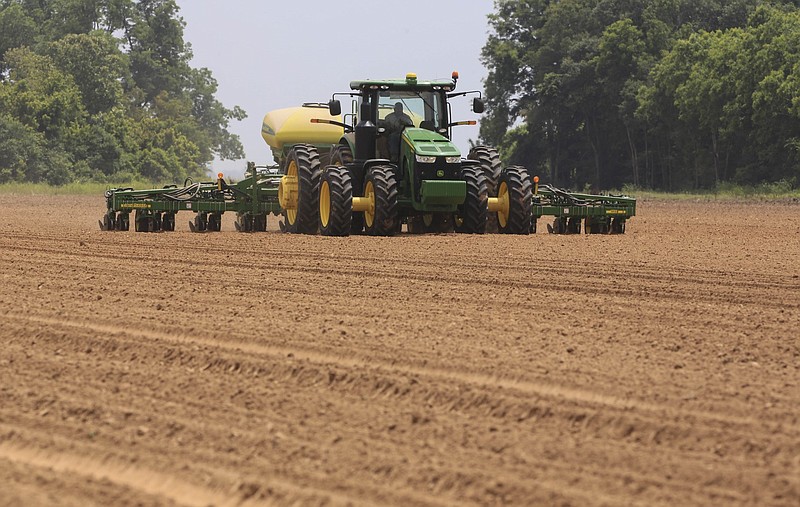Arkansas farmers in March expected they would be planting more more rice, corn, soybean, cotton and peanuts than they actually did, according to the U.S. Department of Agriculture's annual June acreage report.
The USDA's spring prospective plantings report, in which growers were surveyed the first two weeks of March, compared with the annual acreage report, which comes from surveys conducted the first two weeks of June, shows decreases across all major crops in Arkansas.
The report, released Thursday, said Arkansas farmers planted 155,000 fewer acres overall of the state's major crops.
University of Arkansas System Division of Agriculture Extension Economist Scott Stiles said he was expecting corn and rice acres to decrease this year, but added, "We didn't really find anything shocking or surprising about the numbers [Thursday], in our opinion, I think things pretty much went the way we thought," Stiles said.
Poor weather conditions resulted in delayed planting this year as cooler, wetter-than-expected weather in spring pushed back planting dates. Farmers have also faced higher input costs on fertilizer and fuel in the wake of the war in Ukraine, as well as challenges related to covid-19 and other factors.
This has affected farmers' abilities to plant on time and decisions about what, and how much, to plant.
"There's a logical order of when you plant certain crops and corn and rice would go in first," Stiles said. "We typically try to start in March but most of the time the bulk of the planting goes into April and we like to start planting rice in April.
"In April, the weather was not cooperative, it was wet and cool, so we missed the most opportune time to plant corn and rice and if that happens, you would think with the strength in soybean prices that we had, you would see some of those intended corn and rice acres shift to beans and ultimately you'd see a higher bean acreage number in June, but we didn't see that," Stiles continued.
University of Arkansas Cooperative Extension Service rice agronomist Jarrod Hardke said it appeared likely earlier this year that soybean acres would be higher this year because of higher farming input costs. Rice also grows in a similar environment and requires less fertilizer than soybeans.
"However, planting days due to wet weather throughout the spring followed by extreme dry conditions have made it difficult to plant as many soybeans as desired," Hardke said.
"In recent weeks, soybeans have been planted into dry soil and irrigated to get them to germinate and grow. Others still have ground prepared but are hopeful rains will bring moisture for planting. So our soybean acres could still reach higher than current estimates, but that remains to be seen. Commodity prices are also changing a great deal right now since the release of [Thursday's] reports."
Soybean acres planted in Arkansas fell slightly short of growers' predictions in March by 50,000 acres, for a total of 3.2 million acres planted.
But Arkansas farmers still planted 160,000 more acres of soybeans than in 2021. Soybean acres also rose about 1% nationally to an estimated 88.3 million acres.
Stiles said Arkansas farmers also experienced historically strong crop insurance guarantees this year.
"As planning got delayed, maybe the growers opted to take the prevented planting payments from their crop insurance rather than shift acres into soybeans, so that may be one explanation of what happened," Stiles said.
The state's rice farmers planted 40,000 fewer acres than expected in March and 60,000 fewer acres compared to last year. It was the lowest rice acreage reported for Arkansas since 2013, according to a University of Arkansas Cooperative Extension Service analysis of the June acreage report Friday.
Rice acres planted nationally fell to 2.3 million acres from 2.5 million reported last year.
Farmers in Arkansas planted 40,000 fewer acres of corn than was expected in March. Corn acres planted in Arkansas fell 140,000 acres compared with last year and have also decreased nationally, despite higher grain prices.
"When you look at the USDA's outlook for Ukraine, they think their corn production is going to be down 41% from last year and they're a big exporter. I think they're the fourth-largest corn exporter in the world," Stiles said.
"So on top of the lower production, they're looking for exports to be down 61% from last year, so if that turns out to be the case and the conflict extends through this year, then that could keep corn prices elevated and that will factor into growers' decisions next year, we could see corn acres increase in '23 as a result."
Farmers planted 20,000 fewer acres of cotton than expected in March, but there was a 20,000-acre increase from what was planted last year. Cotton acres planted nationally increased 11% to 12.5 million acres.
Arkansas farmers planted 5,000 fewer acres of peanuts than expected in March, and 6,000 acres fewer than what was planted last year.
